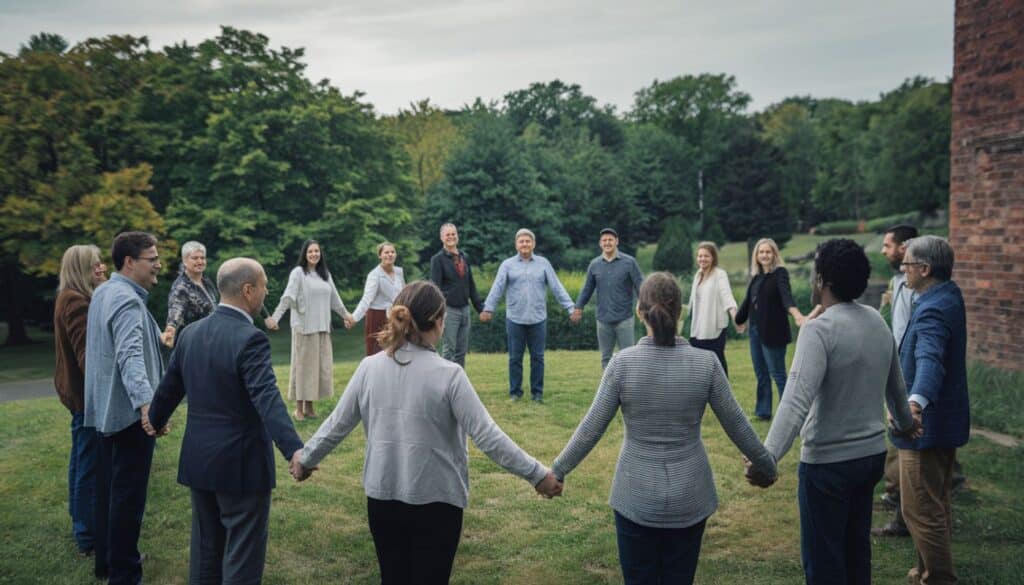Let’s start with a quick scenario: You’re drafting an email to your neighborhood association about an upcoming event. You want to say something about the community’s involvement, but you pause. Should it be community’s, communities’, or just communities? If this has ever tripped you up, you’re not alone. These tiny grammatical distinctions can feel like a minefield, but they’re crucial for clear and professional communication.
Understanding the difference between community’s, communities’, and communities isn’t just about grammar rules—it’s about ensuring your message is precise and polished. Whether you’re writing an email, crafting a report, or posting on social media, getting these details right can make all the difference. In this guide, we’ll break down each form, explain when and how to use them, and provide plenty of examples to help you master this common grammar challenge.
Quick Summary: What’s the Difference?
Before diving into the details, here’s a quick overview:
- Community’s: Singular possessive. Use this when something belongs to one community.
- Communities: Plural form. Use this when referring to more than one community (no ownership).
- Communities’: Plural possessive. Use this when something belongs to multiple communities.
Still unsure? Don’t worry—we’ll explore each of these in depth, with real-world examples and tips to help you avoid common mistakes.
Why the Confusion?
The confusion around community’s, communities’, and communities often stems from their similar spelling and pronunciation. All three forms are based on the same root word (community), but the placement of the apostrophe (or lack thereof) changes the meaning entirely.
For example:
- Community’s (with an apostrophe + s) indicates ownership by one community.
- Communities’ (with an apostrophe after the s) indicates ownership by multiple communities.
- Communities (no apostrophe) is simply the plural form, meaning more than one community.
This subtle difference can trip up even experienced writers, especially when typing quickly or focusing on the broader message. Add to that the fact that apostrophes are often misused in everyday writing (think: it’s vs. its), and it’s no wonder this topic causes headaches.
Detailed Explanation & Correct Usage
Let’s dive deeper into each form, with examples to illustrate their proper usage.

1. Community’s (Singular Possessive)
This form is used when something belongs to one community. The apostrophe + s shows ownership or association.
Examples:
- The community’s park is a hub for local events.
- We’re proud of the community’s efforts to reduce waste.
- The community’s leader shared updates at the town hall.
In each of these examples, the focus is on a single community and something that belongs to or is associated with it.
2. Communities (Plural Form)
This is the simplest form—it’s just the plural of community, meaning more than one group or neighborhood. No ownership is implied.
Examples:
- Urban and rural communities often face different challenges.
- Several communities came together to organize the festival.
- The program aims to support underserved communities.
Here, communities simply refers to multiple groups, with no indication of possession.
3. Communities’ (Plural Possessive)
This form shows that something belongs to multiple communities. The apostrophe comes after the s to indicate plural possession.
Examples:
- The communities’ combined efforts made the fundraiser a success.
- Each of the communities’ leaders attended the summit.
- The communities’ shared resources helped reduce costs.
In these sentences, the focus is on something owned or shared by multiple communities.
Common Mistakes & How to Avoid Them

Even with a clear understanding of the rules, mistakes can happen. Here are some common errors and how to fix them:
Mistake 1: Using Communities Instead of Community’s
Incorrect: The communities park is closed for renovations.
Correct: The community’s park is closed for renovations.
Why? The first sentence suggests multiple communities, but you’re talking about one specific park owned by a single community.
Mistake 2: Using Community’s for Multiple Communities
Incorrect: The community’s programs were funded by the state.
Correct: The communities’ programs were funded by the state.
Here, multiple communities are involved, so the plural possessive (communities’) is correct.
Mistake 3: Omitting the Apostrophe in Possessive Forms
Incorrect: The communities efforts were recognized.
Correct: The communities’ efforts were recognized.
The apostrophe is essential to show possession.
Synonyms or Alternatives
While community’s, communities’, and communities are specific in their usage, there are times when you might want to rephrase for clarity or variety. Here are some alternatives:
- For community’s: “belonging to the community,” “of the community.”
Example: Instead of “the community’s park,” you could say “the park belonging to the community.” - For communities’: “shared by the communities,” “of the communities.”
Example: Instead of “the communities’ efforts,” you could say “the efforts shared by the communities.”
These alternatives can be useful in formal writing or when you want to avoid repetitive phrasing.
Examples in Sentences
To reinforce your understanding, here are more examples in various contexts:
Formal Contexts:
- The community’s proposal was approved by the council.
- Several communities have expressed interest in the new initiative.
- The communities’ representatives met to discuss regional issues.
Informal Contexts:
- Our community’s garden is looking amazing this year!
- I love how different communities come together during the holidays.
- The communities’ potluck was a huge success.
Professional Contexts:
- The community’s feedback will shape the project’s next phase.
- We’re partnering with multiple communities to expand our reach.
- The communities’ collaboration has set a new standard for teamwork.
Origins & History

The word community comes from the Latin communitas, meaning “fellowship” or “shared participation.” Over time, its meaning expanded to refer to groups of people living in the same area or sharing common interests. The possessive forms (community’s and communities’) evolved as English grammar developed rules for indicating ownership.
Interestingly, the use of apostrophes to show possession dates back to the 16th century. Before that, Old English used different endings to indicate possession. The modern rules we follow today were standardized in the 18th and 19th centuries, thanks to the work of grammarians and style guides.
Conclusion & Final Thoughts
Mastering the difference between community’s, communities’, and communities is a small but powerful step toward clearer, more effective communication. Whether you’re writing an email, drafting a report, or posting on social media, using the correct form shows attention to detail and professionalism.
To recap:
- Use community’s for something belonging to one community.
- Use communities when referring to more than one community (no ownership).
- Use communities’ for something belonging to multiple communities.

Emily Hudson, the creative mind behind “English Summa,” is a passionate English language educator with a Bachelor’s Degree in English and a Teaching Certification. Dedicated to making the intricacies of English accessible to learners, Emily brings a blend of expertise and enthusiasm to her readers. Follow English Summa for insightful language tips, literary explorations, and a shared love for the beauty of English.






![# **25 Ways to Say “Have a Good Evening” Professionally** In professional communication, the way you bid farewell can leave a lasting impression. While “Have a good evening” is a polite and common phrase, it can sometimes feel generic or lack the personal touch needed to strengthen relationships. Whether you’re speaking to colleagues, clients, or business partners, tailoring your farewell to the context can demonstrate thoughtfulness, cultural awareness, and professionalism. This article explores **25 professional ways to say “Have a Good Evening”**, complete with real-world scenarios, cultural considerations, and tips to elevate your communication. By the end, you’ll have a toolkit of phrases to suit any professional setting, ensuring your farewells are memorable and meaningful. --- ## **Why Your Farewell Matters** The way you end a conversation or email is more than just a formality—it’s an opportunity to reinforce relationships, express gratitude, and set the tone for future interactions. A well-crafted farewell can: - **Show appreciation**: Acknowledge the time and effort of the person you’re speaking to. - **Reflect professionalism**: Demonstrate your attention to detail and cultural sensitivity. - **Encourage positivity**: Leave the other person feeling valued and respected. In professional settings, the right phrase can enhance your reputation and foster stronger connections. Let’s dive into 25 alternatives to “Have a Good Evening,” each tailored to different contexts. --- ## **25 Professional Ways to Say “Have a Good Evening”** ### **1. Wishing You a Productive Evening** **Scenario**: Email to a Team *“Hi Team, thank you for your hard work today. Wishing you a productive evening as you wrap up your tasks. Let’s regroup tomorrow with fresh energy!”* **Why It Works**: This phrase motivates your team to stay focused while acknowledging their efforts. --- ### **2. Have a Restful Evening** **Scenario**: Closing a Meeting *“Thank you all for your contributions today. Have a restful evening—you’ve earned it!”* **Why It Works**: It emphasizes the importance of recharging, which is especially meaningful after a long day. --- ### **3. Enjoy a Relaxing Evening** **Scenario**: Follow-Up Email to a Client *“Dear [Client’s Name], thank you for your time today. I hope you enjoy a relaxing evening. Looking forward to our next steps!”* **Why It Works**: It conveys warmth and shows you care about their well-being. --- ### **4. Wishing You a Serene Evening** **Scenario**: Email to a Senior Colleague *“Thank you for your guidance today. Wishing you a serene evening ahead.”* **Why It Works**: The word “serene” adds a touch of elegance and calmness, perfect for formal settings. --- ### **5. Here’s to a Gentle Farewell** **Scenario**: Networking Event *“It was a pleasure connecting with you tonight. Here’s to a gentle farewell—until next time!”* **Why It Works**: This phrase is warm and memorable, ideal for informal professional settings. --- ### **6. Wishing You Evening Wishes** **Scenario**: Formal Email Sign-Off *“Thank you for your time today. Wishing you evening wishes as you unwind.”* **Why It Works**: It’s unique and adds a personal touch to your communication. --- ### **7. Enjoy a Well-Deserved Break** **Scenario**: Team Chat After a Busy Week *“Great job this week, everyone! Enjoy a well-deserved break this evening.”* **Why It Works**: It acknowledges hard work and fosters team morale. --- ### **8. Take Care This Evening** **Scenario**: Email to a Colleague *“Thanks for your help today. Take care this evening, and I’ll see you tomorrow!”* **Why It Works**: It’s simple, friendly, and shows genuine concern. --- ### **9. I Hope You Have a Thoughtful Closing** **Scenario**: End-of-Day Recap *“As we wrap up, I hope you have a thoughtful closing to your day. Reflect on your achievements—you’ve done great work!”* **Why It Works**: It encourages mindfulness and self-appreciation. --- ### **10. May Your Evening Be Productive** **Scenario**: Informal Chat with a Colleague *“Before you head out, may your evening be productive! Let’s keep the momentum going.”* **Why It Works**: It’s motivating and keeps the focus on progress. --- ### **11. Here’s to a Positive End to the Day** **Scenario**: Team Meeting Conclusion *“Let’s toast to a positive end to the day! Thank you for your hard work, everyone.”* **Why It Works**: It fosters camaraderie and leaves a lasting impression. --- ### **12. Wishing You a Peaceful Evening** **Scenario**: Email to a Client *“Thank you for your time today. Wishing you a peaceful evening as you review the details.”* **Why It Works**: It’s respectful and creates a calming tone. --- ### **13. May You Enjoy Your Evening** **Scenario**: Closing a Conference Call *“Thank you for your valuable input today. May you enjoy your evening, and let’s touch base again soon!”* **Why It Works**: It leaves a warm impression, encouraging ongoing collaboration. --- ### **14. I Hope You Can Unwind** **Scenario**: Email to a Co-worker *“Thanks for your efforts on the project. I hope you can unwind this evening; you’ve certainly earned it!”* **Why It Works**: It shows empathy and understanding of the need for downtime. --- ### **15. Have a Calm Evening Ahead** **Scenario**: Follow-Up After a Presentation *“Great job today, team! Have a calm evening ahead, and let’s regroup tomorrow to discuss next steps.”* **Why It Works**: It promotes tranquility and sets a positive tone for the following day. --- ### **16. Here’s to a Fulfilling Evening** **Scenario**: Team Building Event *“Thank you for your participation! Here’s to a fulfilling evening with your loved ones. Remember, balance is key!”* **Why It Works**: It reinforces the idea of work-life balance, encouraging employees to value their personal time. --- ### **17. Wishing You Relaxation and Joy** **Scenario**: Informal Email *“Hey Jamie, I wanted to say thanks for your support on the project. Wishing you relaxation and joy this evening! You deserve it.”* **Why It Works**: This friendly approach fosters a positive rapport and acknowledges hard work. --- ### **18. May Your Evening Be Bright** **Scenario**: Casual Goodbyes *“Take care, everyone! May your evening be bright and filled with fun! See you all tomorrow.”* **Why It Works**: It adds a cheerful touch, enhancing workplace relationships. --- ### **19. Hoping You Enjoy a Pleasant Evening** **Scenario**: Formal Email *“Dear Ms. Harris, thank you for your continued support. I hope you enjoy a pleasant evening after a busy day.”* **Why It Works**: It maintains a formal yet warm tone, suitable for professional interactions. --- ### **20. Have a Wonderful Evening Ahead** **Scenario**: Conclusion of a Workshop *“Thank you all for your engagement today. Have a wonderful evening ahead; I look forward to seeing you at our next session!”* **Why It Works**: It encourages ongoing learning and connection. --- ### **21. Here’s to Kind Farewells** **Scenario**: Ending a Client Meeting *“Thank you for your time today. Here’s to kind farewells and a successful partnership moving forward!”* **Why It Works**: It emphasizes mutual respect and the importance of positive relationships in business. --- ### **22. Wishing You a Refreshing Evening** **Scenario**: Email to a Mentor *“Thank you for your advice today. Wishing you a refreshing evening—you’ve inspired me to approach things differently!”* **Why It Works**: It shows gratitude and acknowledges their impact. --- ### **23. May Your Evening Be as Rewarding as Your Day** **Scenario**: Email to a Hardworking Colleague *“Your dedication today was impressive. May your evening be as rewarding as your day!”* **Why It Works**: It’s a creative way to compliment their efforts. --- ### **24. Here’s to a Smooth Transition into Evening** **Scenario**: End of a Busy Workday *“Great work today, everyone. Here’s to a smooth transition into evening—see you tomorrow!”* **Why It Works**: It acknowledges the shift from work to personal time. --- ### **25. Wishing You a Joyful Evening** **Scenario**: Casual Team Chat *“Thanks for the laughs today, team. Wishing you a joyful evening—see you tomorrow!”* **Why It Works**: It’s lighthearted and fosters a positive team culture. --- ## **Cultural and Professional Considerations** When choosing how to say “Have a Good Evening,” consider the following: 1. **Cultural Sensitivity**: In some cultures, overly personal phrases may be seen as intrusive. Stick to neutral, respectful language in formal or cross-cultural settings. 2. **Hierarchy**: When addressing senior colleagues or clients, opt for more formal phrases like “Wishing you a serene evening” or “May your evening be productive.” 3. **Context**: Tailor your farewell to the situation. For example, after a stressful meeting, phrases like “Have a restful evening” or “I hope you can unwind” show empathy. --- ## **Conclusion** The way you say “Have a Good Evening” can significantly impact your professional relationships. By choosing the right phrase for the context, you can leave a positive, lasting impression that reflects your thoughtfulness and professionalism. Whether you’re addressing a team, a client, or a colleague, these 25 alternatives will help you elevate your communication and foster stronger connections. Next time you bid farewell, try one of these phrases and observe how it shapes the tone of your interactions. Remember, a thoughtful goodbye is more than just words—it’s an opportunity to show appreciation, build rapport, and leave a lasting impact.](https://englishsumma.net/wp-content/uploads/2025/02/25-Ways-to-Say-Have-a-Good-Evening-Professionally-In-professional-communication-the-way-you-bid-farewell-can-leave-a-lasting-impression.-While-Have-a-good-evening--150x150.jpg)







